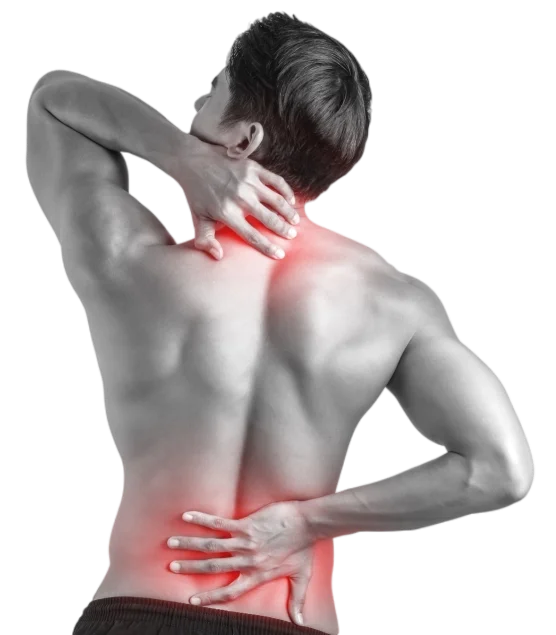Sciatica Treatment
in Mumbai
A typical day in the life of a Mumbaikar involves getting up early, having a quick breakfast, climbing the stairs hurriedly, spending long hours commuting in uncomfortable positions, and trying to reach the destination on time even though it requires walking fast on the sideways with potholes or uneven surfaces. Am I right?
Believe it or not, all these habits contribute to sciatica pain. I work as a sciatica doctor in Mumbai, and when cases arise, I first ask about patients’ lifestyles. Our habits and lifestyles are crucial factors leading to sciatica pain.
I was thinking about how these habits contribute to sciatica pain.

Mumbai-Specific Risk Factors for Sciatica Pain
Commuting
As mentioned earlier, long hours spent in uncomfortable sitting positions while commuting can strain the spine.
Uneven Surfaces
Uneven sidewalks or potholes while walking or riding can cause sudden spinal imbalances and jolts, potentially triggering sciatica.
Sciatica Pain Got You Down? Find Relief in Mumbai!
Here’s how sciatica pain feels like:
Sciatica can be a real pain – literally! If you’re experiencing a shooting pain down your leg that makes sitting, standing, or even sleeping a nightmare, you might be suffering from sciatica.
It was bending down to pick up something and suddenly felt a sharp pain shoot down your back and through your buttocks and leg. It might even feel like a tingling or burning sensation. This is classic sciatica!
The good news is that we offer sciatica treatment if you are in Mumbai.
What is Sciatica?
Sciatica is a nerve pain in the sciatic nerve. It occurs in a leg and is caused by inflammation, injury of the spine, and many other factors.
Often, the pain begins from the lower back and travels down to the buttocks and legs.
Interesting Facts About Sciatica
Sciatica pain
It arises from injury or irritation to the sciatic nerve.
Sciatica symptoms
It can cause pain, tingling, or numbness in the back, buttocks, and leg, potentially radiating down the leg.
Sciatic nerve size
The sciatic nerve is the longest and thickest nerve in the human body, roughly 2 centimeters wide (similar to the width of a U.S. penny or U.K. 1 pence coin).
Sciatic nerve composition
the sciatic nerve is a bundle of smaller nerves branching off five nerve roots in the spinal cord.
Number of sciatic nerves
Humans have two sciatic nerves, one on each side of the body.
Sciatic nerve path
Each sciatic nerve travels through the hip and buttock on its respective side, then runs down the leg until just below the knee.
Sciatic nerve branching
Below the knee, each sciatic nerve splits into smaller nerves that connect to the lower leg, foot, and toes.
Medical Names for Sciatica
Neuropathy - sciatic nerve; Sciatic nerve dysfunction; Low back pain - sciatica; LBP - sciatica; Lumbar radiculopathy - sciatica
Causes of Sciatica
Causes of sciatica include:
Herniated Disc
Spinal Stenosis
Hip joint causes- Piriformis Syndrome
Spondylolisthesis
Other causes
Less common causes include pregnancy, tumors, infections, and injuries like fractures.
How do we identify the area from which the sciatica pain is arising?
The sciatic nerve can be compressed, causing sciatica:
The lower back
The sciatic nerve comes out of the lower back through openings between the vertebrae. If these openings become narrowed due to bulging or prolapsed discs, bony growths, or inflammation of facet joints, they can compress the sciatic nerve, causing sciatica.
The buttocks
The sciatic nerve runs through a muscle called the piriformis in the buttocks. If the piriformis muscle is irritated or spasmed, it compresses the sciatic nerve, and results in sciatica.
You can check the area where sciatica pain arises by performing specific tests.
Diagnostic Tests (if needed)
Slump Test
Sit on a comfortable chair with your hands behind your back. Try to bend forward at the spine, dropping your head towards your chest. If this motion aggravates your sciatic pain, it might indicate a disc-related problem in your lower back.
Extension Test
Lie on your stomach or arch your back as far as possible while on a chair. If this movement worsens your sciatic pain, it could suggest facet joint compression or foraminal stenosis (narrowing of the openings where nerves exit the spine) in your lower back.
Piriformis Test
While seated, find the greater trochanter (the bony part outside your thigh bone). Press into this area and see if it’s tender, especially compared to the other side. If pressing here causes pain, it suggests possible piriformis muscle irritation, which could be causing sciatica.
Symptoms of Sciatica
Sciatica symptoms typically affect one side of your body at a time and radiate along the sciatic nerve path. The sciatic nerve originating from your lower back, runs through your buttocks and leg. Here’s a detailed breakdown of the most common symptoms of sciatica:
Pain
- This is the main symptom of sciatica and can vary in intensity. It’s often described as:
- Burning pain
- Sharp, shooting pain
- Electric shock-like pain
- The pain usually begins in the lower back and buttocks and then radiates down the back of the thigh and calf.
- Certain activities can worsen the pain, such as sitting, coughing, sneezing, bending forward, twisting the spine, or standing for long periods.
Numbness and Tingling:
- You might experience numbness or a pins-and-needles sensation (paresthesia) along the affected leg. This can feel similar to your feeling when your leg “falls asleep.”
- In some cases, numbness might replace the pain entirely, or you might have both pain and numbness in different areas along the nerve path.

Muscle Weakness:
- The sciatic nerve also controls muscles in your leg and foot. Compression of the nerve can lead to weakness in these muscles, making it difficult to:
- Lift your foot off the ground
- Bend your knee
- Stand on your toes
Other Symptoms:
- In some severe cases, you might experience:
- Loss of bladder or bowel control
- This is a severe symptom and requires immediate medical attention.
When should you see a doctor for sciatica pain?
- While sciatica pain can be uncomfortable, it often improves with self-care measures over time. However, there are some situations where you should see a doctor right away, including:
- Sudden numbness or muscle weakness in a leg
- Pain that is severe or gets progressively worse
- Pain after a serious accident or injury
- Trouble controlling your bowels or bladder
- Fever with back pain
If you experience any of these symptoms, it’s essential to consult a healthcare professional for a proper diagnosis and to discuss treatment options.
Treatment of Sciatica in Mumbai
Sciatica treatment in Mumbai focuses on relieving pain, reducing inflammation, and improving nerve function. The approach typically starts with non-surgical methods and progresses to surgery only if conservative measures fail. Here’s a breakdown of treatment options available in Mumbai:
Non-surgical Treatments
Rest and Activity Modification
Taking a break from strenuous activities aggravates the pain and allows inflammation to subside. Light walking and stretching are often encouraged to maintain mobility.
Pain Medication
Over-the-counter pain relievers like ibuprofen or acetaminophen can help manage pain. In some cases, more potent medications prescribed by a doctor might be necessary.
Physical Therapy
A physiotherapist designs a specific program of exercises to strengthen core muscles, improve flexibility, and address any muscle imbalances contributing to sciatic nerve compression.
Spinal Injections
Corticosteroid injections can be administered around the inflamed nerve root to reduce inflammation and pain.
Alternative Therapies
Some people find relief with acupuncture, yoga, massage therapy, or chiropractic adjustments. However, the effectiveness of these methods varies and may not be covered by insurance.
Surgical Treatments for Sciatica in Mumbai
Surgery for sciatica is usually considered a last resort if conservative treatments haven’t provided relief after a reasonable trial period. Here are some surgical options available in Mumbai:
Microdiscectomy
This minimally invasive procedure removes a herniated disc fragment, compressing the sciatic nerve.
Fusion Surgery
In severe cases, spinal fusion surgery might be recommended to stabilize the spine and prevent further nerve compression. This surgery involves placing bone grafts for implants to fix vertebrae together.
Non-surgical Treatment Costs
The cost of non-surgical treatments for sciatica in Mumbai can vary depending on factors like:
- Doctor’s qualifications and experience
- Treatment type (e.g., physiotherapy sessions, medication costs)
- Clinic location
Surgical Treatment Costs
Similarly, surgical treatment costs can be influenced by:
- Surgeon’s fees
- Hospital charges
- Anesthesia costs
- Type of surgery performed
Insurance Coverage
Medical insurance coverage can significantly impact treatment costs. Check with your provider to understand your specific sciatica treatment and surgery coverage.
Can Sciatica Be Prevented?
While some causes of sciatica are unavoidable, there are steps you can take to reduce your risk of developing it. Here are some critical strategies for preventing sciatica
Maintaining good posture
This applies to standing, sitting, and sleeping.
- When standing, keep your ears, shoulders, and hips in a straight line, with your core engaged and knees slightly bent.
- If you sit for extended periods, ensure your chair offers good lower back support and a swivel base. Take frequent breaks to get up and move around.
- Proper sleeping posture is also essential. Choose a supportive mattress and pillow that keeps your spine aligned.
Regular exercise
Staying physically active strengthens your core and back muscles, which helps support your spine and reduces pressure on the sciatic nerve. I advise 30 minutes of moderate-intensity exercise daily for all those who face sciatica pain. Activities like walking, swimming, cycling, and yoga are all beneficial.

Maintain a healthy weight
Excess weight puts extra strain on your lower back, increasing the risk of disc problems that can contribute to sciatica.
Practice safe lifting techniques
Never lift with your back. Always bend your knees and keep your back straight when lifting objects. Avoid twisting your spine while lifting. If the object is too heavy, get help.
Quit smoking
Smoking doesn't directly thicken your blood, but it can make it stickier and more likely to clot. It reduces blood flow to the discs in your spine, weakening them and making them more prone to herniation.
Listen to your body
If you experience back pain, numbness, or tingling in your legs, don't ignore it. Address these symptoms early on to prevent them from worsening into sciatica.
Consider physical therapy
A trained physiotherapist can guide you through exercises to prevent sciatica.
Incorporating these preventive measures into your lifestyle can significantly reduce your risk of developing sciatica. Remember, a healthy weight, strong core muscles, and good posture are your best defenses against back pain and sciatica.
Why is it necessary to consult a professional for Sciatica?
Consulting a professional for sciatica is essential for several reasons:
Accurate Diagnosis
Sciatica pain can mimic other conditions. A doctor can perform a proper examination and imaging tests (if needed) to identify the underlying cause of your sciatica, ensuring you receive the most appropriate treatment.
Effective Treatment
Early professional intervention can help manage pain, reduce inflammation, and promote healing faster. A healthcare provider can create a personalized treatment plan that might include physical therapy, medication, or injections.
Prevent Complications
Left untreated, sciatica can worsen, leading to permanent nerve damage, muscle weakness, and even bowel or bladder control problems. A doctor can help prevent these complications.
Surgery Determination
In severe cases, surgery might be necessary. A healthcare professional can assess if you're a candidate for surgery and guide you through the process.
Underlying Conditions
Sciatica can be a symptom of a more serious underlying condition, such as a spinal tumor or spinal infection. A doctor can rule out these possibilities and ensure you receive proper treatment for the root cause.
Frequently Asked Questions
Several options exist when seeking treatment for sciatica in Mumbai:
- Orthopedic Surgeons: These doctors specialize in musculoskeletal conditions and can perform surgery if needed.
- Spine Specialists: These doctors have additional training in diagnosing and treating spinal conditions, including sciatica.
- Neurosurgeons specialize in surgery involving the nervous system importantly brain. They also can operate the spine.
- Physiotherapists: Look for physiotherapists experienced in treating sciatica using manual therapy and exercise programs.
Non-surgical treatments are usually attempted for 6-12 weeks before considering surgery.
Yes, sciatica can relapse after surgery, although the risk is relatively low.
Providing a specific success rate for Dr. Uday's Spine Hospital or any medical facility is challenging. Success rates depend on various factors. Consult the doctor directly.
Sciatica follows the path of the sciatic nerve and radiates from the lower back to the leg. Therefore, it doesn't typically affect other body parts.
Untreated sciatica can worsen, leading to permanent nerve damage, muscle weakness, and bowel/bladder control issues.

